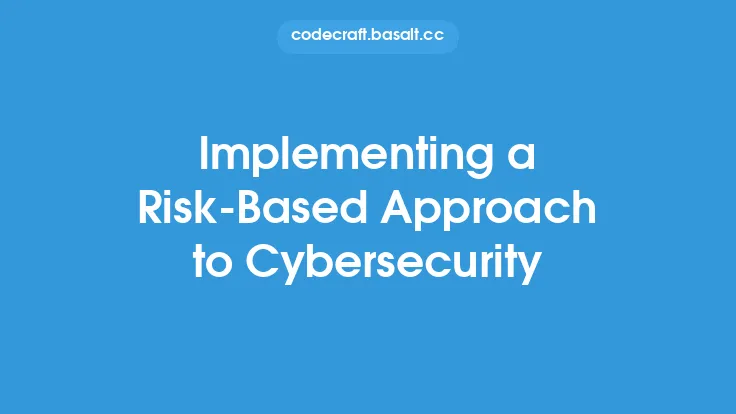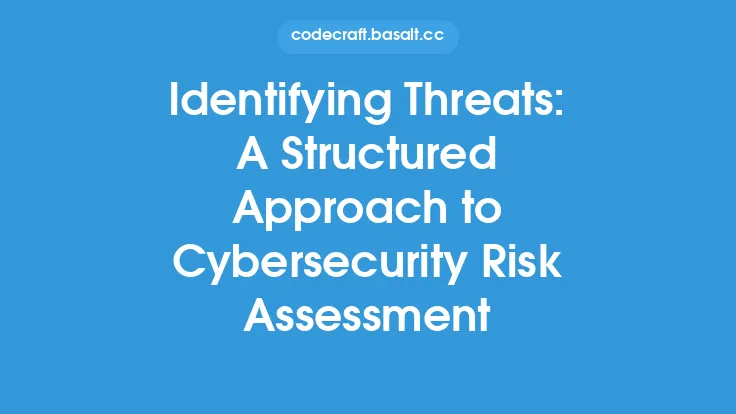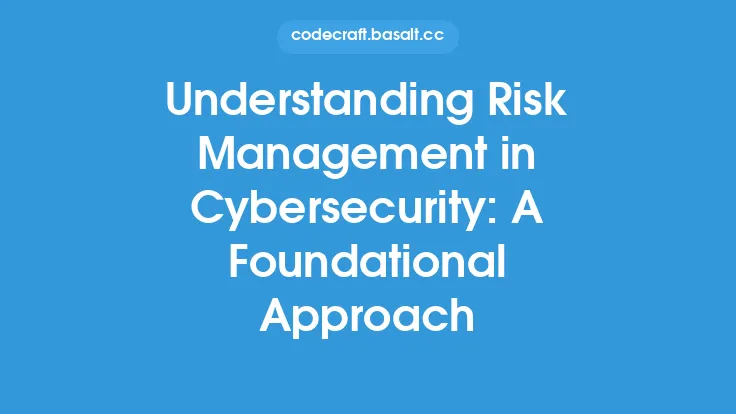In the realm of cybersecurity, managing vulnerabilities is a critical task that involves identifying, classifying, prioritizing, and remediating security weaknesses in an organization's systems, networks, and applications. With the ever-increasing number of vulnerabilities being discovered, it's essential to adopt a risk-based approach to prioritize vulnerabilities effectively. This approach enables organizations to focus on the most critical vulnerabilities that pose the greatest risk to their assets, rather than trying to address every vulnerability equally.
Introduction to Risk-Based Vulnerability Management
Risk-based vulnerability management is a methodology that involves assessing the likelihood and potential impact of a vulnerability being exploited, and then prioritizing remediation efforts based on the level of risk. This approach takes into account various factors, including the vulnerability's severity, the asset's value, the likelihood of exploitation, and the potential consequences of a breach. By prioritizing vulnerabilities based on risk, organizations can optimize their remediation efforts, allocate resources more efficiently, and reduce the overall risk to their assets.
Understanding Vulnerability Severity and Risk
Vulnerability severity is a measure of the potential impact of a vulnerability being exploited, and it's typically classified using a scoring system, such as the Common Vulnerability Scoring System (CVSS). CVSS scores range from 0 to 10, with higher scores indicating greater severity. However, severity alone is not enough to determine the risk of a vulnerability. Other factors, such as the vulnerability's exploitability, the asset's value, and the likelihood of exploitation, must also be considered. For example, a vulnerability with a high CVSS score may not pose a significant risk if it's difficult to exploit or if the asset it affects is not critical to the organization.
Assessing Vulnerability Risk
Assessing vulnerability risk involves evaluating the likelihood and potential impact of a vulnerability being exploited. This can be done using various methodologies, including quantitative risk assessment, qualitative risk assessment, and hybrid approaches. Quantitative risk assessment involves assigning numerical values to the likelihood and potential impact of a vulnerability being exploited, while qualitative risk assessment involves using descriptive categories, such as high, medium, or low. Hybrid approaches combine elements of both quantitative and qualitative risk assessment. Regardless of the methodology used, the goal is to determine the level of risk posed by each vulnerability and prioritize remediation efforts accordingly.
Prioritization Frameworks and Methodologies
Several prioritization frameworks and methodologies can be used to prioritize vulnerabilities based on risk. These include the NIST Cybersecurity Framework, the ISO 27001 standard, and the CVSS scoring system. The NIST Cybersecurity Framework provides a structured approach to managing cybersecurity risk, including vulnerability management. The ISO 27001 standard provides a set of requirements for establishing, implementing, and maintaining an information security management system, including vulnerability management. The CVSS scoring system provides a standardized approach to scoring vulnerability severity, which can be used to prioritize remediation efforts.
Implementing a Risk-Based Vulnerability Management Program
Implementing a risk-based vulnerability management program involves several steps, including vulnerability identification, risk assessment, prioritization, remediation, and monitoring. Vulnerability identification involves using various tools and techniques to identify vulnerabilities in an organization's systems, networks, and applications. Risk assessment involves evaluating the likelihood and potential impact of each vulnerability being exploited. Prioritization involves prioritizing remediation efforts based on the level of risk. Remediation involves taking steps to mitigate or remediate vulnerabilities, such as applying patches or implementing workarounds. Monitoring involves continuously monitoring for new vulnerabilities and reassessing risk on an ongoing basis.
Challenges and Limitations
Implementing a risk-based vulnerability management program can be challenging, and several limitations must be considered. These include the complexity of vulnerability management, the lack of resources, and the ever-increasing number of vulnerabilities being discovered. Additionally, vulnerability management is not a one-time task, but rather an ongoing process that requires continuous monitoring and reassessment. To overcome these challenges, organizations must adopt a structured approach to vulnerability management, allocate sufficient resources, and prioritize remediation efforts based on risk.
Best Practices and Recommendations
Several best practices and recommendations can be followed to implement a risk-based vulnerability management program effectively. These include adopting a risk-based approach, using standardized scoring systems, prioritizing remediation efforts, and continuously monitoring for new vulnerabilities. Additionally, organizations should establish clear policies and procedures for vulnerability management, allocate sufficient resources, and provide training and awareness programs for development teams. By following these best practices and recommendations, organizations can optimize their vulnerability management efforts, reduce the risk of breaches, and protect their assets more effectively.
Conclusion
In conclusion, prioritizing vulnerabilities based on risk is a critical task in cybersecurity that involves assessing the likelihood and potential impact of a vulnerability being exploited and prioritizing remediation efforts accordingly. By adopting a risk-based approach to vulnerability management, organizations can optimize their remediation efforts, allocate resources more efficiently, and reduce the overall risk to their assets. While implementing a risk-based vulnerability management program can be challenging, several best practices and recommendations can be followed to overcome these challenges and implement a effective program. Ultimately, a risk-based approach to vulnerability management is essential for protecting an organization's assets and reducing the risk of breaches in today's ever-evolving cybersecurity landscape.





